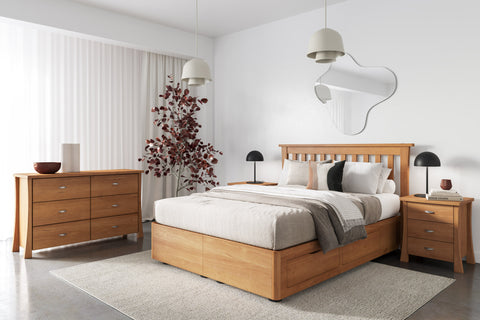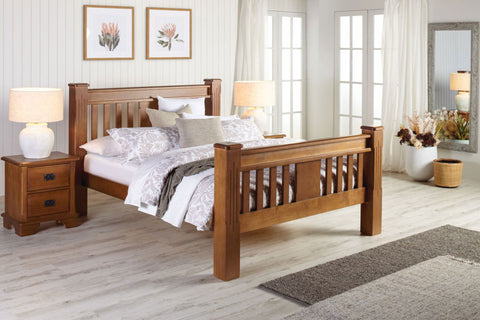There are a lot of different furniture styles out there, and we know it can be hard to know which one will suit you and your home. To make your decision easier, we have explained a selection of the most common New Zealand furniture styles, and how to achieve them. Whether you think you know your style, or wouldn’t have a clue where to start, nothing is more important than to make your home ‘you’! So we encourage you to read on to find out more, and hope you will find it helpful to make your house a home.
Contemporary Style
Contemporary style furniture is simply what is currently happening in design. “As each decade passes, the decor trends of the day will always be considered contemporary.”-The Spruce. Neutrals, black and white is the main palette, with colour brought into the room through artwork, décor, and metal accents.

Clean, bold lines in furniture design such as Coastwood’s Ohope range (above), typify contemporary style. You should avoid curves, as this style is all about the structural look. Contemporary style is ever-evolving, therefore if you love to be on trend and have the budget to change up décor every few years, this style would be suited to you. For most of us, changing up our furniture as trends shift is not sustainable so choosing a simple design like the Mckenzie or Reva (below) is key to avoid your space going out of date. “Select contemporary style home furnishings that are statement-making conversation starters while remaining pared down, with smooth, clean, geometric silhouettes and straight lines” the Décor Aid Team recommends.

The focus is really on retreats that are uncluttered and visibly easy on the eyes. Put simply, less is more. For this reason don’t be afraid of blank (or ‘negative’) spaces; as Coral Nafie, interior stylist, explains ““A contemporary style of decorating is defined by simplicity, subtle sophistication, deliberate use of texture, and clean lines. Interiors tend to showcase space rather than things.”.
Minimalist Style
Currently taking the consumer world by storm, the minimalist furniture style is en vogue. It is far from being a passing trend, as we realise the benefits that uncluttered spaces, neutral colours and simple furniture has on our well-being.
Furniture will be the show piece in your minimalist space so it’s important to invest in beautiful pieces. “Minimalism for me is about keeping a space simple, uncluttered and accentuating the attractive architectural features of a space.” Sharon Blaustein from B Interior LLC explains. Minimalist furniture has clean silhouettes but this isn’t limited to straight lines."
The biggest challenge minimalism poses is achieving a warm and welcoming space. You start with a neutral room and bring in layers of natural tones through the furniture and décor. Texture brought in through timber grain such as Ash, and using light, warm timber tones such as Coastwood’s Light Oak, Cinder, or Natural Ash, prevent it from appearing too soulless.
Minimalism doesn’t mean perfection, though the insta-worthy photos push the concept. It focuses around a ‘less is more’ approach, for those who prefer to keep their furniture for decades and change the décor around when trends change. So keep the designs simple. Coastwood’s Bruno Dining range has clean edges and consistent lines, while the Karamea Bedroom range features simple curves that will soften your space.
Not willing to clear out the pieces you have collected up over the years? Invest in furniture with large storage capacity, like the Portland collection. “Minimalists may have less out on show, but that doesn’t mean they give up all their belongings and necessities. Instead, their homes are jammed packed with clever storage that allows the rooms to appear almost empty” says the Urban Rhythm style team. So minimalistic furniture is functional too. As Sharon Blaustein from B Interior LLC puts it, "Minimalism and functionality go hand in hand”.
In the Sleepneat bedroom (above) designed by Andrew Hill from Coastwood, he says “All the furniture had to be functional. We wanted a retreat that felt restful. The drawers in the Sleepneat Bed Base keep extra belongings out of view, and the Hudson Bedside and Lowboy drawers were large enough to keep all the clothing in without needing to clutter the small room with additional furniture storage. Even the mirror is a statement without being obtrusive”
Want to take the minimalist look further than furniture? This helpful article has a step by step guide to convert your home into a restful retreat.
Urban Style

Industrial, street, and contemporary styles all merge together to create Urban style furniture design. Think of a city studio apartment – what springs to mind? High ceilings, exposed brick or beams, and steel. Urban furniture is exactly this vibe – a blend of solid wood, concrete, metals, leather, and appreciation for natural wood imperfections. Your focus is on comfortable furniture as opposed to industrial’s colder, architectural style. “When choosing urban-style furniture for a modern apartment, you should consider that it should be comfortable, functional, simple, and concise.” - Small Design Ideas.

Urban style tends to continue similar style furniture throughout the home so it flows well, so look for a collection that spans both bedroom and dining furniture, such as Coastwood’s Neo range. You can use different colours to distinguish between your rooms, as shown in the Neo Dining (above) and Bedroom (below); pictured in Crate and Maple finishes.
Coastwood’s Fenton Dining and Bedroom range is another great option for your Urban furniture with its roughsawn solid top. Embrace the natural textures and grain of wooden furniture for true Urban influence.
Traditional Style

If you are after a furniture style that is timeless, opt for pieces that characterise traditional design. Also known as Classic, this type of furniture design remains chic even as trends evolve.
Traditional furniture generally is found in dark wood tones, such as Maple or Coffee, which bring warmth into a room. However, if you’re trying to make a room look bigger it’s a good idea to break up dark tones with lighter woods. Natural Ash is a great way to balance warmth with light – and it’s a wood that never goes out of fashion. You can then add bronze accents, supple leather, and ornamental details to create an inviting home space. When selecting traditional design furniture, focus on the details which bring the piece to life; crown moulding, bevelled edges, and turned legs are characteristic of this style. The Maison bedroom collection (pictured below) really shows how life is brought in through furniture design. Andrew Hill, designer, feels the traditional style furniture makes the room; “the details of the bed really brought personality to the otherwise fairly simple bedroom.”
Traditional furniture is focused on pieces that are functional for your family life. As interior stylist Emily Henderson says, “Modern Traditional evokes a sense of gathering and family in a very casual, unfussy way”, for example Coastwood’s extension tables that seat from Grandma to the youngest member. Investing in pieces that last the test of time so you can pass down to future generations will really make them a family treasure.
Scandinavian Style
Inspired by the Nordic lifestyle, Scandinavian (or Scandi) design furniture is characterised by simple design, all-white palettes, light timbers, and natural fabrics. This furniture style works particularly well with the timbers found in New Zealand homes, and pairs well with the Coastal style furniture. In his interview with Oneroof NZ, Interior designer Mal Corby agrees, saying “It also speaks to the relaxed beachy vibe prevalent in many Kiwi coastal homes.”
Scandi furniture prioritises design so as to be functional and understated. Pieces are simple with clean lines similar to those of the minimalistic style. The pale Natural and White Paint finishes are classic colours found on most Scandi furniture. Pieces often feature slim profile tops and legs, such as found on the Hilton collection pictured above. The soft rounded legs display thoughtful craftsmanship treasured by the original Scandi designers.
Looks isn’t the only key element to achieving a Scandi style. Consider the background of your furniture before buying. True Scandi furniture is made slow, using responsibly sourced timber. If your furniture is made using FSC (Forestry Stewardship Council) certified timber you can rest easy. This certification guarantees the timber has been supplied from a producer who manages forest’s responsibly – “FSC certification ensures that products come from responsibly managed forests that provide environmental, social and economic benefits.” - FSC.
Boho Style


Bohemian furniture embraces informal design. Furniture is often a random blend of different styles that have been collected over the years; be it through travel, inheritance, or second-hand bargains.
While for this reason it is hard to pinpoint an exact design of furniture for the Boho style, there are particular materials that are attributed to it. Use pieces made from natural timber; its imperfections and organic grain adds to the informal feel. Furniture with tassels, rattan, jute, and burlap are characteristic of Boho style too.

A more elegant ‘Modern Boho’ trend has come about in recent years, where more streamlined, detailed furniture is combined with the original relaxed designs. Coastwood Furniture’s Bayswater Collection is perfectly suited to this trend, with its unique yet classy form. Above it is pictured in the Mid Grey paint finish, which works as a neutral base for layering up Boho décor and bedding.
Coastal Style
Living on the West Coast of New Zealand perhaps explains why most of Coastwood Furniture’s collections are Coastal inspired!
Coastal furniture is simple in design, incorporating “natural elements from scenic beaches and coastlines, such as natural woods, jute, rattan, and linen fabrics” Masterclass interior design guide. Rounded shapes such as shown on our Barclay Round Coffee Table (below) are classic Coastal occasional furniture shapes.
Most furniture designs will achieve the Coastal style, so long as two key elements are followed: a simple design, and a light timber finish. Possibly the most common colour that Coastal furniture is found in, is Whitewash. However, light timbers such as the Natural Ash, Sand and Light Oak, or the White and Mid-Grey Painted finishes are also synonymous with this style.
The Tiffany Collection setting styled by Smiths City, pictured below, shows just how easily a Coastal dining setting can be achieved. The pale timber creates a fresh and simple base, similar to the sand and seagrasses found on our beaches. Add a touch of nautical décor and collect some driftwood from the beach et voilà!
Coastal furniture is often found in New Zealand homes, particularly the bedroom. The light timbers and beachy casual vibes create an idyllic peaceful retreat, like the Orinda bedroom pictured below. While the furniture shape is simple, the grooved detail on the sides of the units replicates the boardwalks of piers. Doesn’t this just make you feel like you are on the beach?!
At the end of the day, while styles have specific characteristics, there's no hard and fast rules, it's all about using them as inspiration and tailoring to your personal taste. Combining different styles is very common and has lead to more new and exciting styles such as Transitional, Modern Farmhouse and French Country. For a cohesive look try to stick to 2 or 3 styles maximum and follow a common colour palette to avoid clutter and confusion and base. Most importantly, have fun with it and good luck creating the home of your dreams!



































